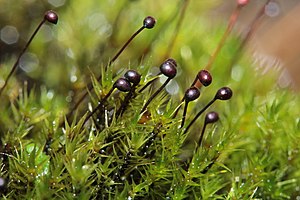Dark black head moss
| Dark black head moss | ||||||||||||
|---|---|---|---|---|---|---|---|---|---|---|---|---|

Dark blackhead moss ( Catoscopium nigritum ) |
||||||||||||
| Systematics | ||||||||||||
|
||||||||||||
| Scientific name of the order | ||||||||||||
| Catoscopiales | ||||||||||||
| Ignatov & Ignatova | ||||||||||||
| Scientific name of the family | ||||||||||||
| Catoscopiaceae | ||||||||||||
| Bread. | ||||||||||||
| Scientific name of the genus | ||||||||||||
| Catoscopium | ||||||||||||
| Brid. | ||||||||||||
| Scientific name of the species | ||||||||||||
| Catoscopium nigritum | ||||||||||||
| ( Hedw. ) Brid. |
The dark black- headed moss ( Catoscopium nigritum ) is a species of deciduous moss . It is the only species of the order Catoscopiales that only includes the family Catoscopiaceae with the genus Catoscopium .
features
The dark black-headed moss forms dense, loosely connected lawns that are olive-green on top and brownish on the inside, often encrusted with lime. The 1 to 5 (rarely up to 10) centimeter high plants are branched, uniformly leafed and rhizoid-tomentose below. The trunk cross-section shows a large and well-developed central cord. The upright, protruding leaves are about 1 cm long, lanceolate and pointed, the leaf margins entire and rolled up. The strong vein extends to the tip of the leaf. The leaf cells are short rectangular, elongated at the leaf base.
The spore capsule on the 1 to 1.5 centimeter long seta is ovate-spherical, 1 millimeter long, shiny red-brown to blackish and horizontal to inclined, the capsule lid is conical. The outer peristome with 16 irregular teeth is yellowish, the inner peristome is absent or is only indicated by a cell membrane. The fine-black, brownish-yellow-green spores are 38 to 50 micrometers in size. Spore ripening time is in summer. The gender distribution is diocesan .
Location claims and distribution
The moss grows on moist, lime-rich subsoil at the edges of streams, in spring corridors, in swelling moors, in cuttings, damp dune valleys and on seeping rocks.
The distribution is circumpolar arctic-alpine with occurrences in Europe (with Iceland), in the Caucasus, in Northeast and Central Asia as well as in North America and Greenland. In Central Europe it occurs mainly in the Alps, but is otherwise very rare or completely absent.
Systematics
The systematic classification of the isolated species was and is controversial. It was originally assigned to the Meesiaceen (Schimper, 1860, Limpricht, 1895), later placed in a separate family Catoscopiaceae next to Meesiaceae (Brotherus, 1924, Podpera, 1954). Griffin & Buck (1989), on the other hand, suggested an alternative placement in the Bartramiaceae family . Based on molecular analyzes, the species finally ended up in the newly created monotypic order Catoscopiales in the subclass Dicranidae .
literature
- Jan-Peter Frahm , Wolfgang Frey : Moosflora (= UTB . 1250). 4th, revised and expanded edition. Ulmer, Stuttgart 2004, ISBN 3-8252-1250-5 , p. 340.
- Martin Nebel, Georg Philippi (ed.): The mosses of Baden-Württemberg. Volume 2: Special part, (Bryophytina II, Schistostegales to Hypnobryales). Ulmer, Stuttgart 2001, ISBN 3-8001-3530-2 , p. 142 f.
Individual evidence
- ↑ Wolfgang Frey, Michael Stech, Eberhard Fischer: Bryophytes and Seedless Vascular Plants (= Syllabus of Plant Families. 3). 13th edition. Borntraeger, Berlin et al. 2009, ISBN 978-3-443-01063-8 , p. 155.
- ↑ Michael S. Ignatov, Ulyana N. Spirina, Elena A. Ignatova, Michael Krug, Dietmar Quandt: On the systematic position of the moss genus Catoscopium, with a new approach to the study peristomes reduction. In: Arctoa. Vol. 24, 2015, ISSN 0131-1379 , pp. 389-415, doi : 10.15298 / arctoa.24.32 .